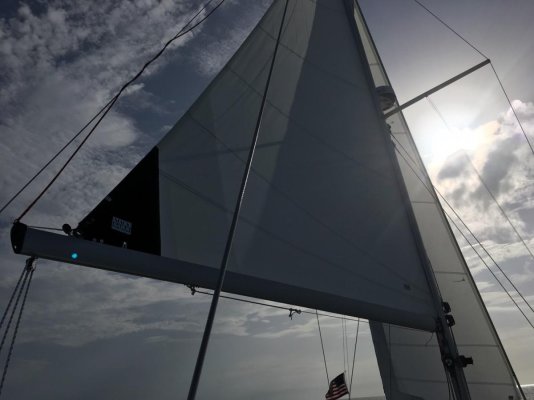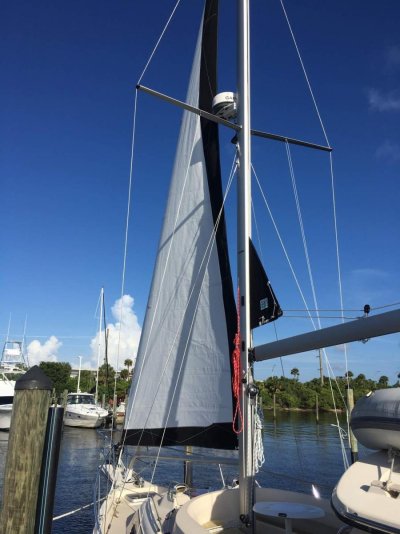cardude01
Guru
- Joined
- Nov 26, 2012
- Messages
- 5,290
- Location
- USA
- Vessel Name
- Bijou
- Vessel Make
- 2008 Island Packet PY/SP
So as some here may know, I recently had a steadying/get home sail rig installed on my boat. It consists of a 40' mast with an in mast furling main and a furling jib. The total sail area is about 380 square feet.
My thoughts so far, after a three week trip (too short) to the Abacos:
1. I found out that just the weight of the rig alone, with no sails deployed, dampened the roll from normal-size wakes quite a bit. Before the roll from wakes was very snappy and violent, but now it's a much slower, gentle roll.
2. It seems the wind needs to be over 10 knots for the sails to have much effect on speed, and really 15 knots is ideal. Because I'm always motorsailing at at least 6 knots, if the wind is not blowing at a good clip the boat seems to "outrun" the wind, for lack of the proper sailing term. With winds blowing 10-15, depending on the point of sail, the sails seemed to provide about a knot of speed. They didn't really increase my overall SOG-- I would just pull the engine RPMs down to keep the same 6-7 knots. It was nice to be able to chug along at 1200-1400 rpm at times vs the normal 2000 rpm.
3. Motorsailing on a broad reach or downwind didn't work very well at all for me, or maybe I didn't have the sails set up correctly. Even with winds of 15 knots plus I constantly had trouble filling the sails. This was on the way back across the Gulf Stream and we had some swell to deal with, plus our speed was hitting 9 knots at times so that added to the equation I'm sure. Motorsailing from a close haul to a beam reach was ideal.
4. The effect of the steadying sails close hauled or on a beam reach were significant. With winds at 10-15 knots there is basically no roll at all. We did run healed over a bit, but not radically. Maybe 5-10 degrees?
5. The in mast furling system was probably overkill for this setup. It does make it easier to reef the sail single handed (once I realized I had to be directly into the wind [emoji23]), but I'm not sure it was worth the extra expense.
6. The sail rig is also a great hammock hanger. We slept out a couple of nights with two hammocks hanging from the rigging.
So overall I'm happy with my decision. The sails keep the boat steady in the right wind, and in an emergency they could get me back to land, although at only about 3 knots probably.
Aside:
I just read an article that some engines don't like to run (or lube well) when healed over beyond certain amount. Does anyone know the angle where it could become a lube starvation problem?
My thoughts so far, after a three week trip (too short) to the Abacos:
1. I found out that just the weight of the rig alone, with no sails deployed, dampened the roll from normal-size wakes quite a bit. Before the roll from wakes was very snappy and violent, but now it's a much slower, gentle roll.
2. It seems the wind needs to be over 10 knots for the sails to have much effect on speed, and really 15 knots is ideal. Because I'm always motorsailing at at least 6 knots, if the wind is not blowing at a good clip the boat seems to "outrun" the wind, for lack of the proper sailing term. With winds blowing 10-15, depending on the point of sail, the sails seemed to provide about a knot of speed. They didn't really increase my overall SOG-- I would just pull the engine RPMs down to keep the same 6-7 knots. It was nice to be able to chug along at 1200-1400 rpm at times vs the normal 2000 rpm.
3. Motorsailing on a broad reach or downwind didn't work very well at all for me, or maybe I didn't have the sails set up correctly. Even with winds of 15 knots plus I constantly had trouble filling the sails. This was on the way back across the Gulf Stream and we had some swell to deal with, plus our speed was hitting 9 knots at times so that added to the equation I'm sure. Motorsailing from a close haul to a beam reach was ideal.
4. The effect of the steadying sails close hauled or on a beam reach were significant. With winds at 10-15 knots there is basically no roll at all. We did run healed over a bit, but not radically. Maybe 5-10 degrees?
5. The in mast furling system was probably overkill for this setup. It does make it easier to reef the sail single handed (once I realized I had to be directly into the wind [emoji23]), but I'm not sure it was worth the extra expense.
6. The sail rig is also a great hammock hanger. We slept out a couple of nights with two hammocks hanging from the rigging.
So overall I'm happy with my decision. The sails keep the boat steady in the right wind, and in an emergency they could get me back to land, although at only about 3 knots probably.
Aside:
I just read an article that some engines don't like to run (or lube well) when healed over beyond certain amount. Does anyone know the angle where it could become a lube starvation problem?
Last edited:








